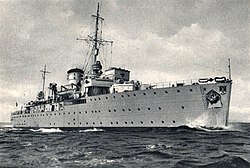Tsingtau (ship, 1934)
|
Tsingtau
|
||||||||||||||||||
|
||||||||||||||||||
|
||||||||||||||||||
|
||||||||||||||||||
|
||||||||||||||||||
|
||||||||||||||||||
The Tsingtau was a speedboat accompanying ship of the German Reichsmarine or Kriegsmarine that was used in World War II .
Construction and technical data
The Reich and Kriegsmarine needed correspondingly equipped escort ships for their speedboats, which were put into service from 1930 . Special ships were necessary because every flotilla needed an escort ship that would serve as accommodation for the boat crews and as fuel, ammunition, fresh water and food depot for the boats. At first they made do with the North Sea , a converted steamship for island service to Heligoland, which, however, was not an ideal solution due to its age and its low speed and was not built for this purpose. The Reichsmarine therefore ordered the Tsingtau as the first S-boat tender in 1933 . In many respects it was similar to the submarine escort ship Saar, which was built around the same time, and was smaller than the S-boat escort ships Carl Peters and Adolf Lüderitz built after it .
The ship was in 1933 as a replacement for the obsolete North Sea as a fleet tender at Blohm + Voss in Hamburg commissioned ran there on June 6, 1934 from the stack , and was put into service on September 24 1934th It was 87.46 meters long (waterline 85.00 m) and 13.5 m wide, had a 4.01 m draft and displaced 1980 tonnes (standard) and 2490 t (maximum). Two four-stroke MAN diesels with a total of 4,100 hp gave it a top speed of 17.5 knots . The range of action was 8,500 nautical miles at a cruising speed of 15 kn. The ship was armed with two 8.8-cm L / 45 guns and four (from February 1940 eight) 2-cm anti- aircraft machine guns. The crew numbered 149 men; As a training ship, the Tsingtau had up to 102 additional men on board.
history
After completion of the test drives, the Tsingtau served from November 3, 1934 to February 1940 as the escort ship of the 1st Schnellbootshalbflotille with the first six new S-boats built since 1932. When the boat S 9 was added on June 12, 1935 , it was renamed the 1st Schnellbootsflotilla. With the commissioning of further boats, the 2nd Schnellbootsflotilla with the escort ship Tanga was set up on August 1, 1938 . Both flotillas were commanded by the leader of the torpedo boats (FdT), who in turn was subordinate to the commander of the reconnaissance forces (BdA).
When the attack on Poland in September 1939, the Tsingtau was involved with six boats of the 1st Schnellbootflotille. On January 6, 1940, she was replaced as the escort ship of the 1st Flotilla by the new Carl Peters , and from mid-February 1940 she served as an anti-aircraft training ship with eight 2 cm anti-aircraft cannons.
During the "Weser Exercise" company , the Tsingtau brought army troops and soldiers from a naval artillery company to Kristiansand in Norway as an escort ship of the 2nd Schnellbootsflotilla and thus as part of "Warship Group 4" in order to occupy the port there. After that, she and the speedboats initially stayed in Norway to carry out patrol service in the fjords .
At the end of April, the ship returned to Germany with its S-boat flotilla, where it served from May to July as a cadet training ship for the inspection of the training system and then until mid-August as a target ship for the 1st torpedo boat flotilla. On August 21, 1940, the Tsingtau moved to Rotterdam as an escort ship for the speedboats stationed there . From October 1940 she was the companion of the 4th Schnellbootsflotilla.
In 1941 the Tsingtau was relocated to the Baltic Sea, where she served various flotillas as an escort ship until April 1944 - first the 5th, from February 15, 1942 the 6th, then the 7th, and in June / July 1942 the 8th speedboat flotilla . Then from July 1942 to April 1943 she was directly subordinate to the Führer der Schnellboote (FdS). In April 1943 she was assigned to the 9th Schnellbootsflotille, which operated in the English Channel .
When the Schnellbootsschuldivision was set up in April 1944, the Tsingtau came as an escort ship to the 2nd Schnellboots School Flotilla. She remained there until the end of the war, but was also available to the driver of the speedboats several times during this time. Towards the end of the war, numerous missions followed in the Baltic Sea to bring as many people as possible from East and West Prussia to the West. On the night of May 5, 1945, the Tsingtau and their speedboats evacuated 3,500 people from Hexengrund in Gdańsk Bay . On May 8, 1945 around 9:30 p.m., the last convoy left the port of Libau , with the Tsingtau and other ships bringing another 15,000 people west.
The End
After the war ended, the Tsingtau became British spoils of war on May 10, 1945 . Until 1947 she served under British orders with the German mine clearing service , as a tender for the 4th mine clearing division.
In February 1950 the ship was brought to England and scrapped at Clayton & Davie in Dunston on the Tyne ( Northumberland ) .
literature
- Erich Gröner: The ships of the German navy and their whereabouts 1939-1945 , JF Lehmanns, Munich, 1976
- Hans-H. Hildebrand, Albert Röhr, Hans-Otto Steinmetz: The German warships , 10 volumes, Koehlers Verlagsgesellschaft, Hamburg, ISBN 3-8364-9743-3
- Volkmar Kühn: Schnellboot im Einsatz 1939-45 , Motorbuchverlag, Stuttgart, 3rd edition, 1997, ISBN 3-87943-450-6
- Siegfried Breyer: Special and special ships of the Kriegsmarine (I), Marine-Arsenal Volume 30, Podzun-Pallas-Verlag, Eggolsheim-Bammersdorf, 1995, ISBN 3-7909-0523-2
